The MGA With An Attitude
|
| MGAguru.com |
|
MGAguru.com |
COMPETITION DE-LUXE SEATS for the MGA -- INT-114A
Construction and Webbing
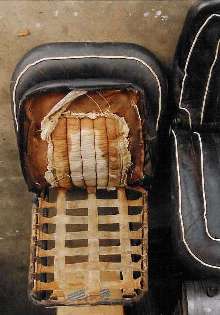 Pictures of these tatty original MGA "Competition De-luxe" seats speak volumes about internal construction and assembly. Thanks to Tom Tallone for donating those pictures. Click for larger images.
Pictures of these tatty original MGA "Competition De-luxe" seats speak volumes about internal construction and assembly. Thanks to Tom Tallone for donating those pictures. Click for larger images.
Starting with the picture at right we see bottom cover and foam pad removed, and the face of the back cover stripped away. The vertical pleated piece is the remains of the thin cloth covering on a cotton pad which was once attached to the inside of the pleated leather face cover. Behind that is a thick molded foam rubber cushion similar to the base cushion. Like standard Roadster and Coupe seats, these will be covered with leather on the front surfaces and on the most accessible side surfaces, and vinyl on the less accessible sides and across the back.
 The next picture at right is the same base frame, detached, with the leather cover which was removed from the back frame. Notice the slight angle on the base frame on the side which goes next to the tunnel, wider at the back and narrower at the front, similar to other MGA seats. The heavy cloth webbing is looped around and stitched onto steel wire clips which hook into small holes in the tube frame. The contoured foam rubber seat squab is supported on the webbing, and the outer fabric cover will be stretched over everything.
The next picture at right is the same base frame, detached, with the leather cover which was removed from the back frame. Notice the slight angle on the base frame on the side which goes next to the tunnel, wider at the back and narrower at the front, similar to other MGA seats. The heavy cloth webbing is looped around and stitched onto steel wire clips which hook into small holes in the tube frame. The contoured foam rubber seat squab is supported on the webbing, and the outer fabric cover will be stretched over everything.
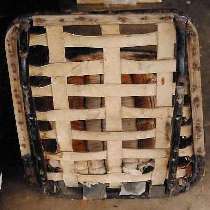


Next above left we have the same base frame inverted, showing the wood strips which are screwed to the bottom of the frame to accept tacks or staples for fastening the cover in place. On the right the same frame again, this time with the wood strips removed and laying at the sides. From here you can unhook the steel wire clips to remove the webbing, leaving the frame bare for cleaning and painting.

Here above we have the backrests with the outer fabric covers removed. On the right we have the front of the driver side seat back (LHD car) showing a cloth cover over thin cotton batting which protects the foam rubber back cushion. Notice the folded white cloth sewn on around the edge. This is used as reinforcing for the cloth which is stapled to the wood tack strips on the back side of the perimeter tubing. The white cloth also serves as a thin pad on the front side of the tubing where the wire hooks for webbing are installed. On the left we have the back side of the passenger seat (LHD car) showing the tube frame, the webbing, and the molded foam back cushion. Notice the front cloth cover is still attached here, wrapped around the edges and tacked on the back side. You can see cotton batting protruding from under the edges of the dark cloth. Although being a slightly different shape (flat across the top), the tube frame is similar in construction to the standard seats. Notice the kick in the side which goes next to the tunnel, and the less pronounced form on the outboard side.
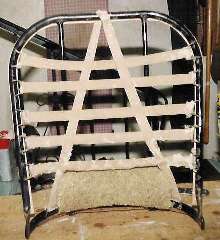

Above we have two pictures of the driver side backrest (LHD car). On the left the front side, and on the right the back side. Here the web straps are layered (not in basket weave). The horizontal straps are installed first, then the angled vertical strap is looped over the top tube and laid in front of the horizontal straps. All strap ends are sewn onto wire hooks to attach to the tube frame (picture below). At the bottom is a small horsehair lumbar support pad about one inch thick, similar to the pad used in the standard seats but not as tall. With the cloth and cushion removed you can see the wood tack strips which are screwed onto the back side of the backrest perimeter frame.
What is NOT shown here is a heavy card stock backing board which wraps around the back of the backrest frame, similar the standard seats. This should also be covered on the back with a thin soft cloth pad prior to installation of the outer cover. This may possibly have been felt, which makes a good replacement, but was more likely originally a soft woven layered cloth pad.
Original seats used two webbing sizes with wire clips of different sizes to suit.
Seat Back Web 1-1/8" (28mm) - - Wire Clip - 1-3/8" (38mm) between ends of clip.
Seat Base Web 1-1/2" (38mm) - - Wire Clip 2" (50mm) between ends of clip.
Original clips are made of two pieces of wire (pictures below).
The Newton Commercial webbing kits use only 38mm webbing for seat base and back and this is stitched to a single piece wire clip. The Newton webbing kit comprises 15 straps per seat as follows:
1 strap - 95.5cm (37-5/8") - vertical on back
5 straps - 39.0cm (15-3/8") - horizontal on back
3 straps - 50.5cm (19-7/8") - front to back in base
6 straps - 32.5cm (12-3/4") - side to side in base (was originally 7)
These dimensions are for the unstretched webbing excluding clips (webbing 38mm wide). Tall people may allow extra length. Then you could loosen or tighten to suit.


Newton Commercial webbing kit and tack strips kit
Apparently original seats had seven straps side to side in the base where Newton Commercial uses only six. It appears they intend to position the six straps half way in between locations of the original seven, requiring wider spacing for the wire clip ends to match original holes in the base frame.
Thanks to Christopher Cox for the following pictures.

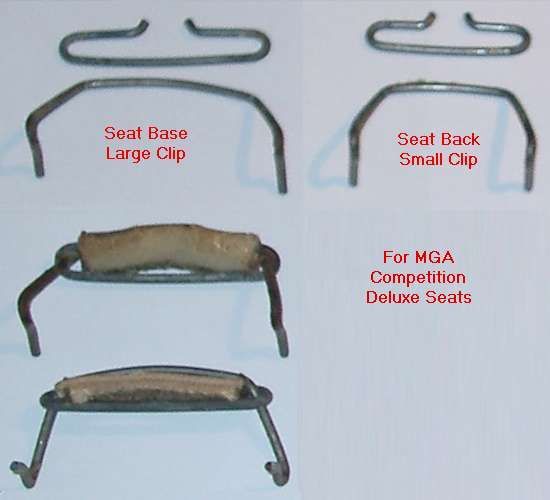

With the original style 2-piece wire clips no stitching is required for the webbing. Loop the strap through the 2-piece clip as shown. Pull the tail to tension the strap. Tension on the strap pulls the smaller piece of the clip up tight to lock the webbing in place. Working with webbing off a bulk roll can yield little or no scrap. Thread the web through one clip, then across the frame to the other side, and then through the second clip. Adjust the tail end at the second clip to the desired length, and pull the long part of the strap to lock the clip. Then pull the bulk roll strap to pull the web back through the first clip to tension the strap in the seat frame. Finish by cutting the web to the desired tail length near the first clip.

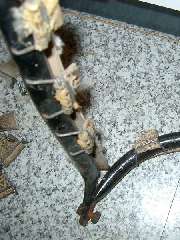

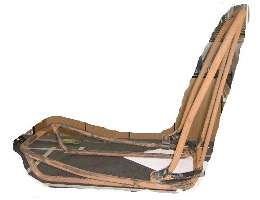
Here we have a picture of the bare seat frame. Thanks to Peter Steyn in South Africa for this picture. The back rest is similar to a roadster seat, except being flat across the top rather than angled to match the body tonneau. The bottom frame is much different. Slider track holes are also in a different position to that of the standard frames.
Materials to rebuild the MGA Competition De-luxe seats may be available from:
At 11:55 AM 11/15/05, Bob Ertzinger wrote:
"Got a quote from NTG Motor Svc.UK dated 9-11-05 for:
1-J705A Seat kit-De-luxe MGA L 394.38
2-Base Cushion-De-luxe MGA 43.44 L 86.88
2-Padding Backrest-De-luxe 37.45 L 74.90
Shipping L 60.00 to my address
Total L 616.16
Their conversion rate could be from 1.6 to 2.0
depending on the current rate."
At 06:45 PM 11/21/05, Bob Ertzinger wrote:
"FYI, Called Heritage Upholstery (360-332-3022). Duncan is salesperson.
Made to copy original using English auto-grade leather and English vinyl.
$880/pair - seat covers.
$150/2 - bottom cushions
$ 95/2 - backs
$ 40 - backboards if needed
$ 60 - tack strips if needed
$ 35- S&H -- 4-6 weeks for delivery.
NTG is cheaper by $92 for covers and cushions only
In February 2010, 38mm (1-1/2") webbing was available from "upholsterysupplyman" on eBay. Also available from www.skiddawupholstery.co.uk
 Photo from Peter Steyn in South Africa
Photo from Peter Steyn in South Africa
|
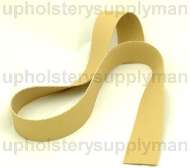
Photo from eBay
|
At 06:07 PM 1/21/2015 +0000, David Adams wrote:
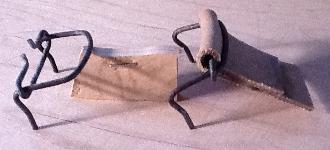 "Some of the prongs on the 1-1/2 inch webbing clips in the seat were worn almost through where they had chafed against the holes in the seat frame. I bought new webbing and the clips ('A' clips) from Skiddaw Upholstery Supplies, www.skiddawupholstery.co. These 'A' clips are identical to the original. The buckles are no longer available but these don't wear out".
"Some of the prongs on the 1-1/2 inch webbing clips in the seat were worn almost through where they had chafed against the holes in the seat frame. I bought new webbing and the clips ('A' clips) from Skiddaw Upholstery Supplies, www.skiddawupholstery.co. These 'A' clips are identical to the original. The buckles are no longer available but these don't wear out".
|


















